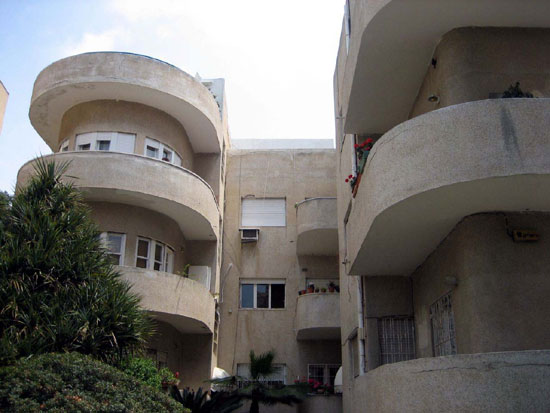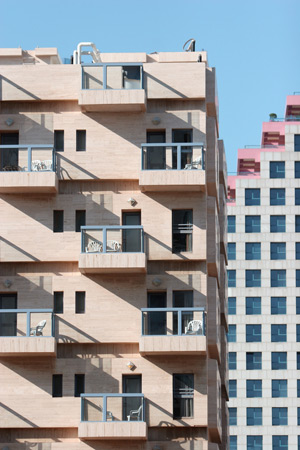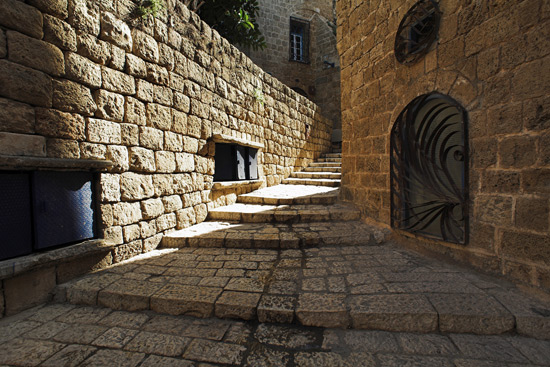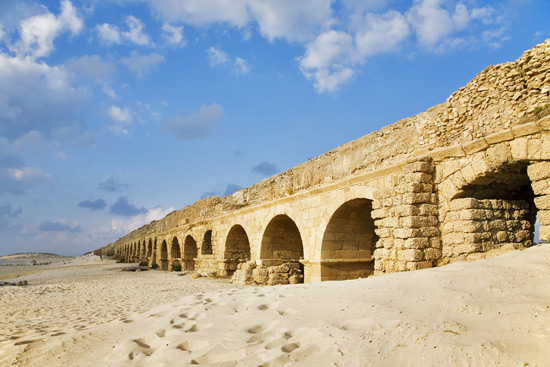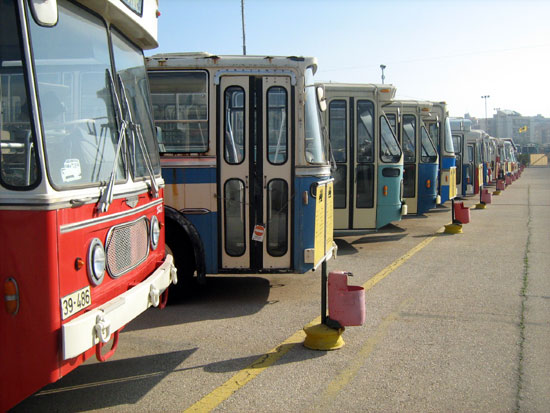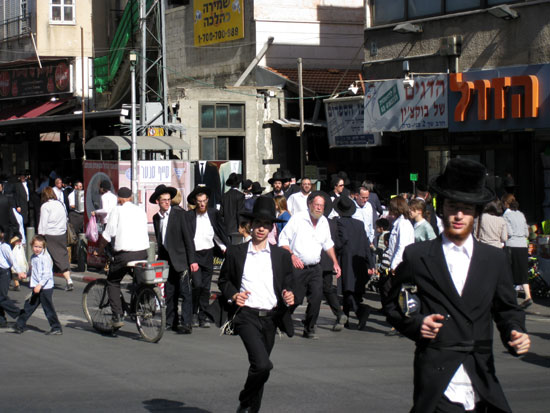In the City
Bauhaus Tour
Architecture buffs will appreciate Tel Aviv’s Bauhaus phenomenon. The clean, white architecture, brought to Tel Aviv by German immigrants in the early part of the 20th century, became so prevalent that Tel Aviv is nicknamed "the white city." In 2003, Tel Aviv was named a UNESCO World Heritage Site in honor of its treasure trove of Bauhaus-style buildings.
The more than 4,000 buildings in Tel Aviv that fall into the Bauhaus category are defined by their light color (most buildings are not so white anymore) and simple design devoid of frivolity. The one decorative piece common to the architecture is the presence of small balconies. The clean lines and light colors were designed to merge with the larger scheme of Tel Aviv’s urban, Mediterranean landscape and its accompanying hot weather.
Tours, either with a live guide or an audio guide, are conducted out of the Bauhaus Center on Dizengoff Street. While official tours cover many famous houses in the Bauhaus style, the casual tourist can also simply walk the central city area for a sense of its architecture.
Bauhaus buildings are all over the city, but for a nice walk, start at the northern tip of Rothschild Boulevard and stroll south down its pedestrian walkway. There are myriad possible routes: for a loop, take a right onto Balfour Street, then another right onto Ahad Ha’am Street, which will bring you right back to where you started. For a longer walk into south Tel Aviv—where much Bauhaus style is to be found—continue on Rothschild to Nachmani, Nachalat Binyamin, or Lillenblum Streets. From any of these points head northwest toward King George Street to get back to the city center. Another option is to go north: from Dizengoff Center, head north to Gordon Street and take a left, then take another left onto Frug Street. Head back south on Frug to Ben Ami Street. Take a right onto Dov Hoz Street, and head back up toward Gordon. This kind of zig-zag will assuredly expose some of Tel Aviv’s signature Bauhaus style, and you can continue to snake through the city for as long or as short a time as desired.
Foundations of Israel Tour
See Tel Aviv through the eyes of its pioneers. Start in Neve Tzedek, the first neighborhood outside of Jaffa, established in 1887. Enter via Shlush Street, named after Aharon Chelouche, an Algerian Jew and one of the first Neve Tzedek settlers. "Chelouche" has been spelled phonetically in English, rendering it "Shlush." Aharon Chelouche’s house is at 32 Shlush Street.
Be sure to stop by the Rokach House (36 Rokach Street), the home-turned-museum of Shimon Rochach, one of Neve Tzedek’s founders. The small museum tells the story of the settlers' lives and dreams through art, furniture, clothing, photography, and more. At 21 Rochach Street is Beth Hatefutsoth (the Nahum Gutman Museum), a building dedicated to the works of the influential Israeli artist and writer who immigrated to Palestine in 1905.
Heading east out of Neve Tzedek on Lillenblum Street, take a left onto Hertzl Street and a right onto Rothschild Street. At 16 Rothschild is Independence Hall (also known as the Dizengoff House), the home of Tel Aviv’s first mayor where Israel’s independence was declared on May 14, 1948. Continue on to 23 Rothschild to the Haganah Museum. The Haganah, the precursor to the Israel Defense Forces, formed in 1920 as a response to Arab attacks, and later played an integral role in smuggling Jewish refugees into the land and winning Israel’s independence. The museum is the former home of Haganah founder Eliyahu Golumb, and where secret meetings were held in the early days of Jewish settlement.
If there you have time and energy left over, head north to first Prime Minister David Ben Gurion’s house (17 Ben Gurion Boulevard.). Ben Gurion bequeathed his home to Israel, and now visitors can step inside the world of this early Zionist leader, which remains the way he left it at the time of his death in 1973. The library on the second floor contains approximately 20,000 books and periodicals, many of which detail Israel’s history and establishment.
Jaffa Tour
Starting at the promenade along the sea, follow the road up to Old Jaffa’s summit. There are usually a few crafts and clothing vendors at the top near St. Peter’s Church, and on a good day the visitor to Jaffa will catch a wedding party. No wonder, as this is Tel Aviv’s most picturesque spot. Although the origins of the name "Jaffa" aren’t fully known, it is similar to the Hebrew word for "beautiful," and it doesn’t seem like a far stretch from the rocky crest overlooking the Mediterranean. Being such a prime spot in Middle East geography, Jaffa has witnessed every Western civilization and religion, including some biblical figures and even the legendary Greek figure, Andromeda, who was chained to a rock facing Jaffa as a sacrifice to a sea monster. The story (commemorated by four constellations) relates that Andromeda was saved by Perseus, who married her.
Jaffa is marked by synagogues, churches, mosques, archaeological finds, and memorials. Meander the stone alleys, which are named after the zodiac, and pop into artist studios, galleries, and upscale shops. Follow the Mifratz Shlomo Promenade down to Beit Eshel Street, and find Shuk HaPishpeshim (the flea market) off to the right. This is a great place to wander around. Try out sitting on all the vintage couches or look for the strangest object for sale in this bizarre bazaar. Depending on one’s patience for window shopping, the entirety of tourist-friendly Jaffa is suitable for at least a half day. It’s a good idea to plan for lunch in Jaffa, particularly at the famous Dr. Shakshuka or the eccentric Puah.
Free Organized Tours
There are at least four free tours organized around various themes in Tel Aviv. One is a night walking tour that tells the story of Tel Aviv’s founding; it leaves from the corner of Rothschild Boulevard and Herzl Street at 8 p.m. every Tuesday. A Bauhaus tour leaves from 46 Rothschild Boulevard every Saturday at 11 a.m. Visitors can tour Jaffa every Wednesday at 9:30 a.m., beginning at the clock tower. Finally, there is a Tel Aviv University art and architecture tour every Monday at 11 a.m. Meet at the Dyonon Bookstore at the campus entrance (at the intersection of Haim Levanon and Einstein Streets). These tours are all free, and no advance registration is necessary.
Outside the City
Caesarea
Caesarea is a wealthy seaside town about 45 minutes north of Tel Aviv, easily reached by train and car. The city’s history is ancient, dating back to the Phoenician, Greek, Roman, and Byzantine civilizations. Of the many archaeological findings in Caesarea are Herod’s palace and port, two Greek temples, the oldest remaining Roman amphitheater in the eastern Mediterranean, and ancient aqueducts. Tours are available around the historical area, including a "musical tour" for those not embarrassed to sing in public. Visitors are also invited to step back in time at the Time Tower or by watching "The Caesarea Experience," which traces the city’s civilization back through the millennia. Hikers and sporting types will not be let down by the array of trails and activities in this beautiful town. Most intriguing are diving tours in the harbor, where everyone from the amateur to the experienced diver can encounter sunken sites. Those more interested in relaxation will appreciate Caesarea’s superb beach culture. Caesarea is also one of the only places in Israel with a golf course.
Egged Museum
Riding the bus is a way of life for Israelis. On Thursdays and Sundays, buses are packed with soldiers going to and from military bases; women load and unload their baby strollers with ease; even the elderly are seen in the front seats riding without complaint. In short, everyone in Israel relies on the bus system. Therefore, it makes perfect sense to have an entire museum dedicated to the history of Israeli buses. Egged, one of Israel’s main bus operators, runs a museum outside of Tel Aviv with more than 60 buses that have been collected. Some have cute nicknames, like "Komet" and "Tiger," while others have historic significance. The museum is in Holon, 20 minutes south of Tel Aviv.
Bnei Brak
And now, for something entirely different. In contrast to the secular (and arguably hedonistic) lifestyle of Tel Aviv is neighboring Bnei Brak, one of the most religious Jewish neighborhoods in the world. Mentioned in the Bible as a city of the tribe of Dan (Joshua 19:45), it was also a place of importance for 1st-century Judaism. In 1924 it was settled by Polish Jews, and it has only increased its religious observance since then, continually putting new strictures into place. There is no tourist attraction; the only reason to visit Bnei Brak is if you have someone to visit there or if observing a Haredi community is of particular interest. And that's the point: Bnei Brak should not be overlooked as a fascinating place in the diverse Israeli landscape. If you go, be sure to dress modestly—women are best off wearing loose skirts and blouses and men should cover their heads.
Article written for World Trade Press by Emily Keeler Alhadeff.
Copyright © 1993-2026 World Trade Press. All rights reserved.



